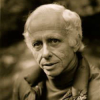George Leonard

George Leonard
George Burr Leonardwas an American writer, editor, and educator who wrote extensively about education and human potential. He was President Emeritus of the Esalen Institute, past-president of the Association for Humanistic Psychology, President of ITP International, and a former editor of Look Magazine. He was a former United States Army Air Corps pilot, and held a fifth degree black belt in aikido...
NationalityAmerican
ProfessionLawyer
Date of Birth3 July 1729
CountryUnited States of America
The ultimate creative capacity of the brain may be, for all practical purposes, infinite.
Competition is the spice of sports; but if you make spice the whole meal you'll be sick.
The universe is continually at its work of restructuring itself at a higher, more complex, more elegant level. The novelty, the new, more complex order, doesn't emerge from the present in a steady stream, nor at all places at the same rate. It comes, as all things do, in rhythmic waves; there will always be times and places of scarcity and stagnation and retrogression. Still, the long-term direction is clear. The intention of the universe is evolution.
Practice is the path of mastery.
Preventing the new generation from changing in any deep way is what most societies require of their educators.
Only the schools’ inefficiency can account for creativity surviving after age 25.
The subtle dance of the body joins us to the world.
Everything was God, holy; as God is total, so the driftwood branch was holy. This must be the stuff religion is made of.
Running, close companion to death, summons us to the most vivid acts of life. Our ancestors (we have forgotten) ran for food and for love, love and lust. For us, a prime symbol of sexuality is the automobile. For the ancients it was the chase, the foot race. Satyr and nymph, maiden and god, hot pursuit. The mythic hunters, Diana and Atalanta, available only to the males, men or gods, who could outrun them; death to all others.
It's fitting, then, that we begin this exploration of ourselves and of the world with music, and more specifically with a musical quality called vibrato. This pulsation that wells up within the sounded note can lead us to what is most spontaneous and creative in human life, and possibly even to deeper mysteries--to powers of knowing and doing which we have lost or given away during the epoch of civilization, and which perhaps we may now regain.
There is a human striving for self-transcendence. It's part of what makes us human. With all of our flaws we want to go a little bit further than we've gone before and maybe even further than anyone else has gone before.
What was once impossible now summons us to dismantle the walls between ourselves and our sisters and brothers, to dissolve the distinctions between flesh and spirit, to transcend the present limits of time and matter, to find, at last, not wealth or power but the ecstasy (so long forgotten) of commonplace, unconditional being. For the atom's soul is nothing but energy. Spirit blazes in the dullest of clay. The life of every woman or man-the heart of it-is pure and holy joy.
The simplest single-celled organism oscillates to a number of different frequencies, at the atomic, molecular, sub-cellular, and cellular levels. Microscopic movies of these organisms are striking for the ceaseless, rhythmic pulsation that is revealed. In an organism as complex as a human being, the frequencies of oscillation and the interactions between those frequencies are multitudinous.
History tells us more than we want to know about what is wrong with man, and we can hardly turn a page in the daily press without learning the specific time, place, and name of evil. But perhaps the most pervasive evil of all rarely appears in the news. This evil, the waste of human potential, is particularly painful to recognize for it strikes our parents and children, our friends and brothers, ourselves.